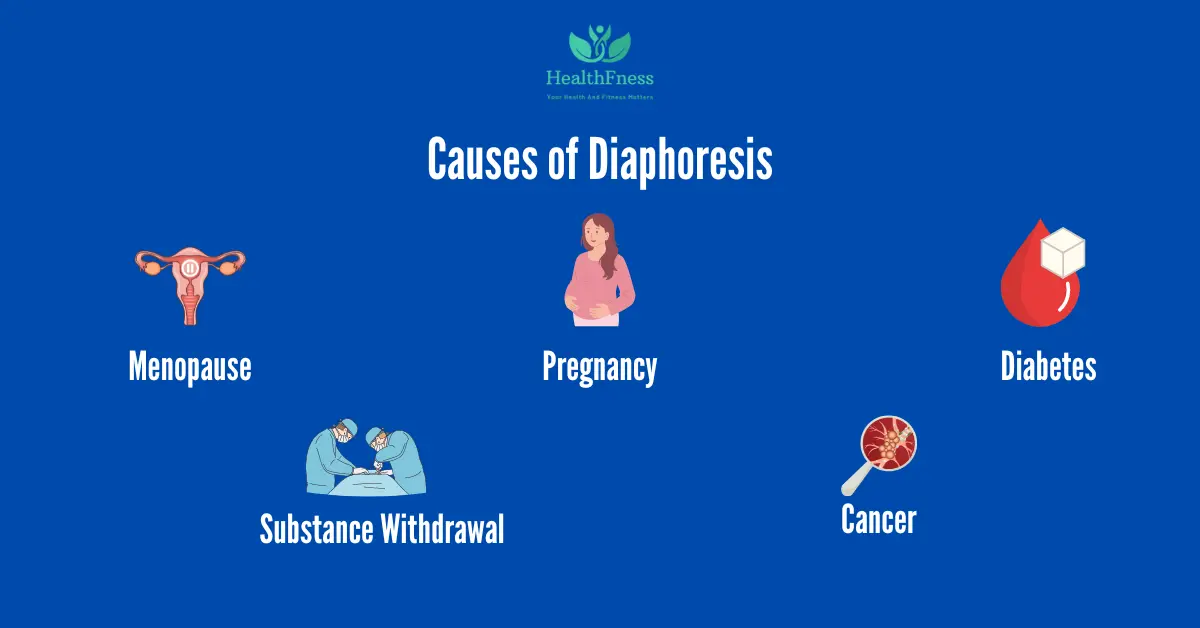Before we explore what is Diaphoresis ICD 10 we must have knowledge about what is Diaphoresis in general so Let’s get started!
Understanding Diaphoresis
Diaphoresis is a scientific term that refers to excessive sweating, either generalized throughout the body or in specific areas.
It may be a regular bodily reaction to warm temperature, exercising, or pressure, or it is able to be a symptom of an underlying medical state of affairs such as hyperthyroidism, menopause, or sure infections. Diaphoresis can be managed through right remedy of the underlying situation, or via addressing triggers including strain or warmness publicity.
You May Also Like To Read: Pleural Effusion ICD 10: Exploring The Code And its Causes
What Is Meant By Diaphoresis ICD 10
ICD 10 is an international disease classification system in which every disease has its unique number which is called its ICD 10 code. ICD 10 code for diaphoresis is R61. This code is used to indicate diaphoresis which means excessive sweating or strange sweating everywhere in the body or in specific regions of the frame.
The R61 code is used as a supplementary or extra code to discover the underlying contamination inflicting the diaphoresis. For example, if a patient has diaphoresis due to hyperthyroidism, the primary diagnosis code would be for hyperthyroidism and the R61 code would be used to indicate excessive sweating.
You May Also Like To Read: Fatty Liver ICD 10: Life Expectancy With Fatty Liver Disease
ICD-10 Code For Night Sweats Unspecified
The ICD-10 code for Night Sweats Unspecified is R61.
ICD-10 Code For Sweats And Chills
Sweats and chills have the ICD-10 code R68.83. This code is used for unexplained febrile convulsions, which might also include chills and sweating signs in addition to convulsions caused by a fever.
What Is Sweat?
Sweat plays a very important role all over the body and it regulates the temperature of a body when body temperature is high due to hot weather, exercise, or any other condition it helps to cool down the body and regulate the temperature.
The sweat gland, that is in fee of manufacturing sweat, secretes a easy, salty liquid. Sweat usually consists of water and electrolytes like sodium and chloride, on the identical time as it can additionally include small portions of urea, ammonia, and glucose. Sweat moreover has a unique heady scent due to bacteria present on the pores and skin.
You May Also Like To Read: Lung Nodule ICD 10: Cracking The Code, Diagnosis, and Treatment
Causes Of Diaphoresis
there are several causes of this disease we will discuss the most common causes of this disorder:
Menopause
Menopause is one of the most known causes of diaphoresis. In menopause hormonal changes occur in the body and women with menopause feel hot flashes and night sweats. Hot flashes are sudden feelings of warmth or heat that can cause sweating, while night sweats are episodes of excessive sweating during sleep.85% of women who have menopause also have issues of excessive sweating which is diaphoresis.
You May Also Like To Read: Lung Cancer ICD 10: Understanding The Code, Diagnosis, And Treatment
Pregnancy
Another common cause of diaphoresis is pregnancy because in this condition hormonal changes occur all over the body, especially in the second and third trimesters also a woman gains weight which causes excessive sweating in pregnancy metabolic rate also increases which also contributes to developing disorders. Some women may experience night sweats during pregnancy, which can be particularly uncomfortable.
Diabetes
Diabetes can also be a reason for the disorder if a person has diabetes and feels excessive sweating then it’s a sign of low blood sugar this condition is also known as hypoglycemia when body sugar is too low-stress hormone releases which causes excessive sweating. This sweating is often accompanied by other symptoms of hypoglycemia, such as shakiness, confusion, and rapid heartbeat.

Hyperthyroidism
The disease known as hyperthyroidism occurs when the thyroid gland overproduces thyroid hormone, which can boost metabolism and body heat production and cause perspiration. Moreover, hyperthyroidism can raise blood pressure and anxiety levels, both of which can result in sweating.
You May Also Like To Read: Vitamin D Deficiency ICD 10: Causes, Symptoms and Treatment
Substance Withdrawal
When a person stops using certain substances, such as alcohol or opioids, the body can react with withdrawal symptoms, including sweating. This sweating can be a result of the body’s attempt to regulate body temperature, which can become dysregulated during withdrawal.
Cancer
Cancer frequently causes sweating, especially in the later stages of the illness. Fever, cancer-related drugs, and even the illness itself, among other things, can all contribute to cancer-related sweating.
You May Also Like To Read: Chronic Pancreatitis ICD 10
What Are The Symptoms Of Diaphoresis?
Diaphoresis, or excessive sweating, can be accompanied by a range of symptoms, including:
- Wet or moist skin
- Unpleasant body odor
- Skin rash or irritation
- Feeling overheated or flushed
- Cold, clammy skin
- Fatigue or weakness
- Dizziness or lightheadedness
- Rapid or irregular heartbeat
- Chills or shivering
The symptoms of diaphoresis can vary depending on the underlying cause. For example, sweating associated with a person who has menopause may be recognized by hot flashes, while sweating associated with diabetes may be accompanied by shakiness and confusion.
You May Also Like To Read: Iron Deficiency Anemia ICD 10: Unpacking Iron Deficiency Anemia
How is Diaphoresis Diagnosed?
The diaphoresis is diagnosed by previous medical history, physical test, and if needed imaging test. For example, if a doctor suspects that a person may have diabetes or hypoglycemia doctor may prescribe a blood test to check your blood sugar level. Your healthcare provider can refer you to a specialist for more testing if they are unable to identify the underlying cause of your diaphoresis.
Treatment For Diaphoresis
There are many methods to treat this disease:
Treatment of underlying medical issues
Depending on what is causing the diaphoresis in the first place, treating the underlying issue may help reduce sweating. For instance, managing diabetes or hyperthyroidism can help lessen excessive sweating.
Medication
Certain drugs can be taken to control excessive perspiration. They consist of:
- Antiperspirants: Over-the-counter antiperspirants containing aluminum chloride can assist reduce sweating.
- Topical creams: Prescription creams containing glycopyrrolate can help reduce sweating in specific areas of the body.
- Oral medications: Prescription anticholinergics or beta-blockers can help reduce overall sweating.
You May Also Like To Read: Cystic Fibrosis ICD 10: Unpacking Cystic Fibrosis and Cracking the Code ICD-10
Botox Injections
Injections of the botulinum toxin type A (Botox) can be used to temporarily block sweat glands and reduce perspiration in particular body regions.
Surgical Procedures
In severe cases of excessive sweating, more invasive treatments may be recommended. These can include:
Sympathectomy: Cutting the nerves that control sweating in certain parts of the body to reduce sweating.
Sweat gland removal: Removing the sweat glands in certain areas of the body to reduce sweating.
You May Also Like To Read: Understanding NonSteroid Hormones
How Can I Prevent Diaphoresis?
However, there are some strategies that may help reduce excessive sweating:
Stay cool
Avoid hot and humid environments whenever possible. Use air conditioning or fans to help keep your body temperature cool.
Dress appropriately
Wear loose-fitting, breathable clothing made of natural fibers such as cotton or linen.
Avoid triggers
Identify and avoid triggers that may cause excessive sweating, such as spicy foods, caffeine, or alcohol.
Use Antiperspirants
Apply antiperspirants containing aluminum chloride to the areas of the body where you sweat excessively.
Practice Good Hygiene
Shower or bathe regularly and use an antibacterial soap to help control odor.
You May Also Like To Read: Does Tylenol Affect Blood Sugar?
Seek Immediate Medical Attention
There are some situations in which a person should seek immediate medical attention:
- Chest Pain Or Pressure
- Shortness of breath
- Confusion or altered mental status
- Dizziness or fainting
- Severe dehydration
If a person feels any one of these symptoms seek medical attention immediately.
You May Also Like To Read: Prediabetes ICD 10: Types, Causes And Treatment
FAQs Section
What is Diaphoresis, and why does it need ICD-10 coding?
Diaphoresis is excessive sweating, and ICD-10 coding is essential for accurate diagnosis and tailored treatment plans.
Which ICD-10 code is assigned for Diaphoresis?
The ICD-10 code for Diaphoresis is R61. This code allows healthcare professionals to categorize and track cases of excessive sweating accurately.
How are ICD-10 codes for Diaphoresis determined?
Codes are determined based on comprehensive documentation of the patient's symptoms, medical history, and any underlying conditions contributing to Diaphoresis.
What are the common mistakes in Diaphoresis ICD-10 coding?
Common mistakes include misinterpretation of symptoms and lack of specificity. Addressing these challenges requires attention to detail and ongoing education for coders.
How does proper coding benefit healthcare processes?
Proper coding streamlines healthcare processes, facilitating accurate billing and insurance claims. Additionally, coded data aids in medical research, contributing to advancements in understanding and treating Diaphoresis.
Can Diaphoresis occur in specific age groups?
Yes, Diaphoresis can arise in people of all age corporations, from infants to the elderly.
Are there special considerations for coding Diaphoresis in pediatric cases?
Yes, the ICD-10 system provides specific codes to address variations in symptoms and conditions related to Diaphoresis in pediatric cases.
How does Diaphoresis ICD-10 coding contribute to research?
Coded data aids in aggregating information, enabling medical researchers to analyze trends, outcomes, and potential links associated with Diaphoresis.
What are the consequences of coding violations in healthcare?
How can patients be involved in the Diaphoresis ICD-10 coding process?
Patients can be knowledgeable about ICD-10 codes, allowing them to actively participate in discussions approximately their fitness and remedy plans.
Conclusion
Diaphoresis is a condition in which sweat production increases in the body and a person has excessive sweating. The ICD 10 Code for diaphoresis is R61. Causes of Diaphoresis include menopause, pregnancy, Diabetes, Hyperthyroidism, Substance Withdrawal, and Cancer.
The symptoms of Diaphoresis include unpleasant body odor, fatigue or weakness and chills or shivering, etc. Diaphoresis is diagnosed by blood tests previous medical history and physical examination. There are also treatment options available to cure this disease like botox injections and surgical procedures.
Video Credits:

Dr. Mark Jenkins, MD - General Physician (California, USA)
Dr. Mark Jenkins is a board-certified general physician based in the United States, specializing in preventive medicine, nutrition, and lifestyle health. With years of clinical experience in primary care, he is dedicated to helping patients and readers alike make informed, science-based decisions about their well-being.
As a trusted medical reviewer and contributor to Healthfness.com, Dr. Jenkins ensures that all health content meets the highest standards of accuracy, safety, and evidence-based medicine. His expertise bridges modern medical science with practical, everyday wellness strategies, making complex topics approachable for all audiences.
Outside the clinic, Dr. Jenkins is passionate about living the healthy lifestyle he teaches. He enjoys hiking with his dog, experimenting with vegetarian cooking, and exploring the latest health research. He believes that small, consistent lifestyle changes lead to lasting health improvements, and he aims to inspire readers to take proactive steps toward a healthier, happier life.
Explore more of Dr. Jenkins’ evidence-based insights at Healthfness.com



